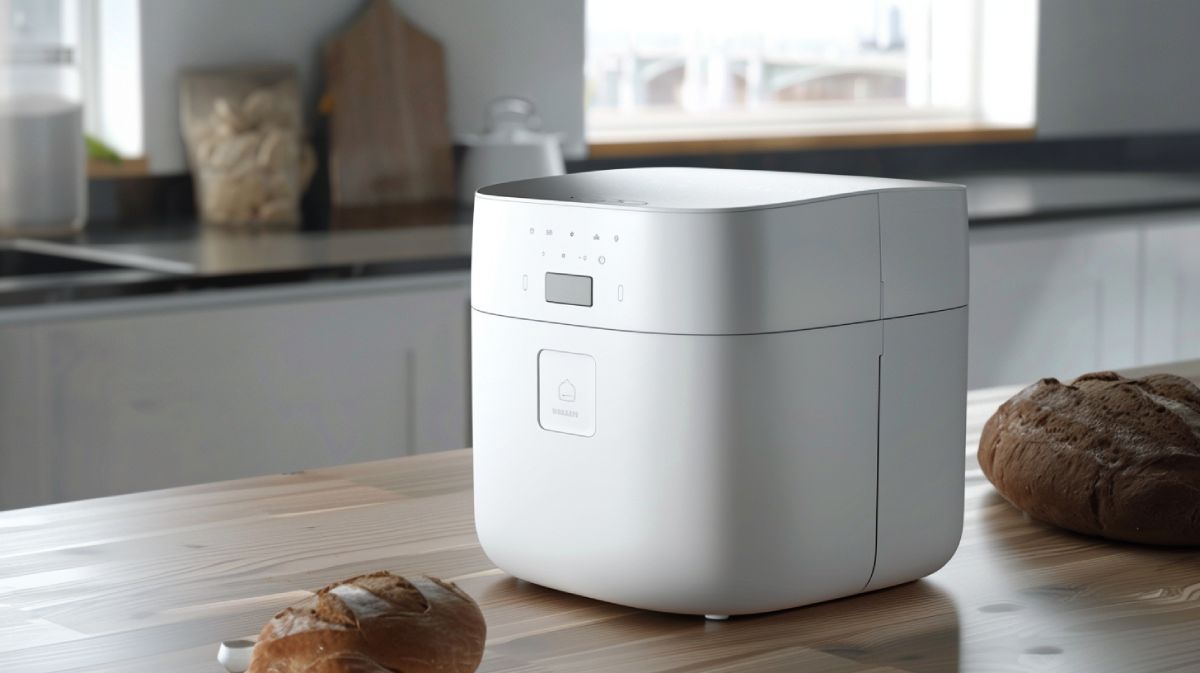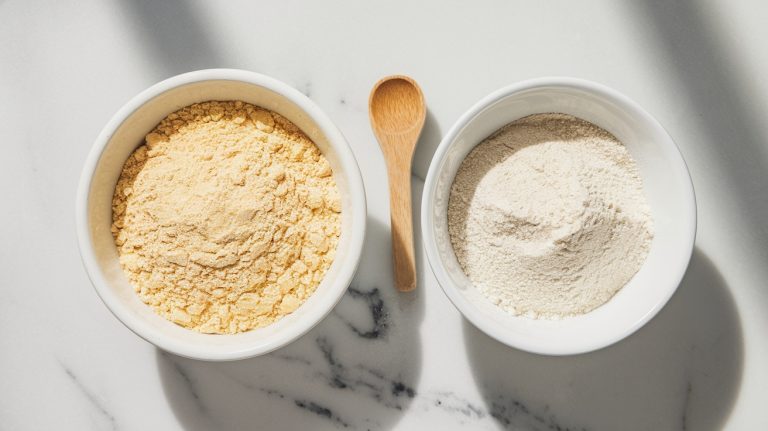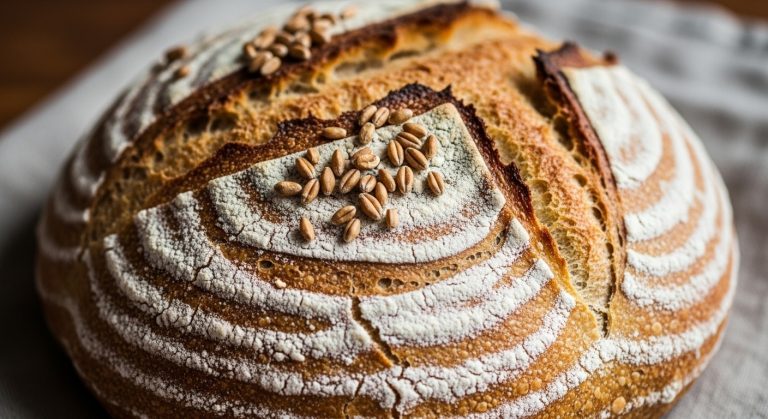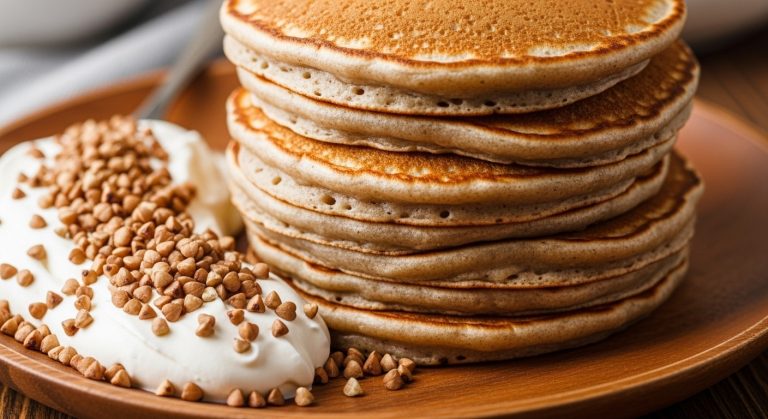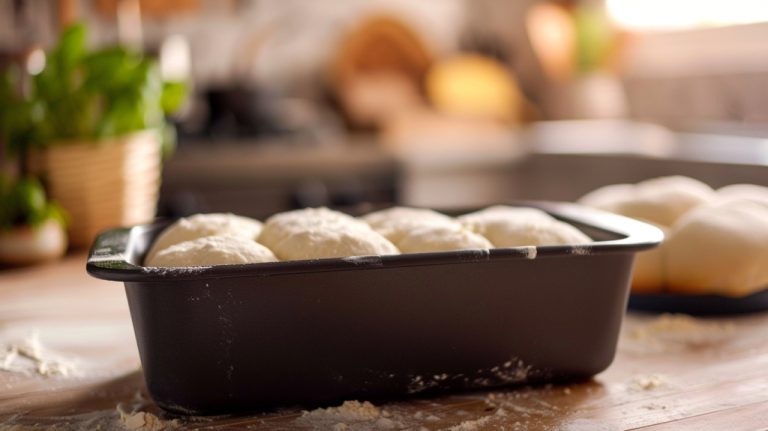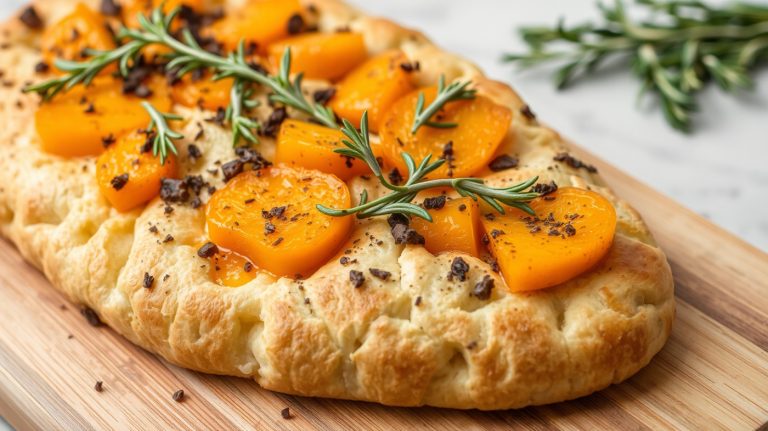Sourdough Bread Recipe for Bread Maker: Quick and Tasty
You can easily whip up a delicious sourdough bread recipe in your bread maker. Start with an active sourdough starter, 1 2/3 cups of bread flour, warm water, a tablespoon of sugar, and a pinch of salt.
Layer the wet ingredients first, then the dry ones, topping it with the starter. Choose the sourdough setting on your bread machine and allow it to knead and rise.
Keep an eye on the consistency of the dough—it should feel tacky. Soon, you’ll have a perfect loaf ready to enjoy. And if you’re curious about enhancing your sourdough skills, there’s more to explore.
Key Takeaways
- Use an active, bubbly sourdough starter fed 4-12 hours prior for optimal rise and flavor.
- Combine 1 2/3 cups of bread flour, 1 1/3 cups of sourdough starter, water, butter, sugar, and salt in your bread maker.
- Select the sourdough cycle or pizza dough setting on your bread machine for proper fermentation and kneading.
- Allow the dough to rise until it doubles in size, approximately 6 hours, before baking for best results.
Recipe Overview and Benefits
This sourdough bread recipe for your bread maker not only simplifies the baking process but also delivers a delightful, fluffy loaf that’s perfect for sandwiches and packed with flavor.
You’ll love the ease of using an active sourdough starter, which is key to achieving that perfect rise and complex taste. With a bubbly starter fed within 4-12 hours, this recipe guarantees your Bread Machine Sourdough Bread will turn out with a soft crumb and an appealing buttery texture.
This recipe stands out with a solid 4.49 rating from 299 votes, showcasing its popularity among home bakers. Plus, you’ll save money, as each loaf costs only about $0.75-$1 to make, considerably less than bakery prices.
Imagine enjoying fresh, homemade sourdough bread without the fuss of traditional baking methods. With this hands-off approach, all you need to do is add the ingredients and let your bread maker work its magic. It yields a 1-pound loaf, perfect for a variety of sandwich fillings.
Share your baking triumphs by tagging @FarmhouseOnBoone and using the hashtag #farmhouseonboone to connect with fellow sourdough enthusiasts!
Essential Ingredients
To create the perfect sourdough bread, you’ll need to understand the essential ingredients and their roles.
Each component, from the active sourdough starter to the type of flour you choose, contributes to the bread’s flavor and texture.
Let’s explore how these key ingredients work together to elevate your sourdough baking experience.
Key Ingredient Functions
Understanding the key ingredients in sourdough bread reveals the secrets to achieving that perfect rise and distinctive flavor. Each component plays a crucial role in delivering a loaf that’s not just delicious but also has the right texture and tang.
- Sourdough Starter: This living culture is packed with natural yeast and bacteria, which work together to leaven your bread and infuse it with that characteristic sour flavor. Without it, your bread would lack both rise and taste.
- Bread Flour: Opt for high-protein bread flour over all-purpose flour. It develops gluten better, resulting in a fluffier, more substantial loaf that holds its shape beautifully.
When you combine these ingredients thoughtfully, you’re well on your way to creating a mouthwatering sourdough that’s perfect for any meal.
Each element harmonizes to give you that ideal crust and soft, chewy interior, making your baking experience rewarding and delicious.
Flour Type Importance
The flour type you choose plays a pivotal role in shaping the texture and flavor of your sourdough bread, influencing everything from its rise to its final crust.
Bread flour, with its higher protein content, is ideal for achieving a fluffy loaf, while whole wheat flour adds a nutritious boost and tangy flavor. If you opt for whole wheat, you’ll notice the sourdough starter thrives on the increased nutrients, enhancing the fermentation process.
It’s essential to evaluate the hydration level of your dough as well. Higher hydration levels, like 75% or more, typically benefit from strong white bread flour, which supports better gluten development. Remember, different flour types absorb water differently; for example, all-purpose flour absorbs less than bread flour, meaning you may need to adjust your water quantities accordingly.
Lastly, the quality and freshness of your flour can’t be overlooked. Using unbleached, high-quality flour directly impacts the performance of your sourdough starter and the overall success of your bread.
Nutritional Information
Sourdough bread typically packs a nutritious punch, offering around 203 calories and a good balance of macronutrients in each hearty slice. When you whip up a batch using your sourdough bread recipe, you’ll enjoy not just the delightful taste but also a range of nutritional benefits.
Here’s a quick breakdown of the nutritional information for each slice:
- Carbohydrates: About 34 grams, providing you with energy throughout the day.
- Protein: Roughly 5 grams, contributing to muscle health and satiety.
Additionally, each slice contains 1 gram of dietary fiber, which helps in maintaining good digestive health.
This balance makes sourdough a satisfying choice, whether you’re enjoying it as toast for breakfast or as a sandwich base for lunch. By choosing homemade sourdough, you not only control the ingredients but also savor the health benefits that come with it.
With such solid nutritional information, it’s easy to see why sourdough bread is a beloved staple in many diets!
Preparation Tips
When it comes to making the perfect sourdough, getting your ingredient measurements right is essential.
You’ll also want to keep your starter in top shape, ensuring it’s well-fed and active before mixing it into your dough.
These preparation tips can make all the difference in achieving that deliciously fluffy loaf you crave.
Essential Ingredient Measurements
To achieve a delicious 1-pound sourdough loaf, gather 1 2/3 cups (200g) of high-protein bread flour, which guarantees a fluffy texture. This key ingredient sets the foundation for your bread, allowing it to rise beautifully.
Next, you’ll need 1 1/3 cups (301g) of a bubbly, ripe sourdough starter. Make sure it’s been fed within 4-12 hours for the best flavor and activity.
Consider these essential measurements to perfect your sourdough:
- 1 teaspoon of granulated sugar: This helps feed the sourdough starter and adds a subtle sweetness.
- 1 teaspoon of table salt: This enhances the overall flavor while ensuring proper yeast activity.
These precise measurements will help you create a well-balanced sourdough loaf. Remember, the quality of your ingredients directly impacts the outcome, so choose wisely and enjoy the process of baking!
Your efforts will reward you with a crusty, golden loaf that’s perfect for any occasion.
Starter Maintenance Techniques
How can you keep your sourdough starter lively and ready for baking? First, decide how often you’ll bake. If you’re baking daily, keep your sourdough starter at room temperature and feed it 1-2 times a day. For weekly bakers, store it in the fridge, but remember to feed it before you use it.
To achieve the best results, maintain a feeding ratio of equal weights of starter, flour, and water. This method minimizes waste while guaranteeing your starter remains active. Consider using wholegrain dark rye flour for its nutrient-rich profile; it promotes healthy yeast and bacteria growth, which is essential for a robust starter.
Look for signs that your sourdough starter is primed for action: it should double in size and have a slightly flattened top after feeding. When these indicators are present, your starter is ready to help your dough to rise beautifully.
Step-by-Step Directions
Start by adding warm water and melted unsalted butter to your bread machine, ensuring a perfect blend that promotes hydration and flavor.
Next, layer in the following ingredients to achieve the best results:
- Bread flour
- Granulated sugar
Be sure to follow the order recommended by your specific bread maker model.
Once you’ve added these dry ingredients, top them with a bubbly, active sourdough starter. This is essential for fermentation and enhances the overall flavor of your loaf.
Now, set your bread maker to the kneading function, which typically lasts around 25 minutes. For a more robust texture, consider an optional second knead cycle to enhance gluten formation.
After kneading, it’s time for the dough to rise. Allow it to rest for approximately 6 hours, ensuring it doubles in size—this step is critical for a light and fluffy loaf.
Once the dough has risen, you’re ready to bake! Following these steps will lead you to a delicious homemade sourdough bread, highlighting the unique flavors brought out by your sourdough starter.
Enjoy the process and the delightful aroma that fills your kitchen!
Common Challenges
Making sourdough bread can be rewarding, but it often comes with its share of challenges that can trip up even seasoned bakers. One common issue is achieving the right dough consistency. Your dough should feel slightly tacky and stretchy, which may require you to adjust the water or flour based on your sourdough starter‘s hydration level.
Over-proofing is another hurdle; if you let your dough rise too long, the texture can suffer. It’s essential to monitor the rise and guarantee it doubles in size before baking.
If you’re using bread machines, selecting the appropriate kneading and baking cycles is significant since many machines lack a specific sourdough setting. The quality of your sourdough starter can also impact your bread’s flavor and rise. Always use a freshly fed, bubbly starter for the best results.
Finally, bread machine users might notice paddle holes in their loaves. To avoid this, try removing the dough right after the kneading cycle to achieve a cleaner crust.
Bread Machine Settings
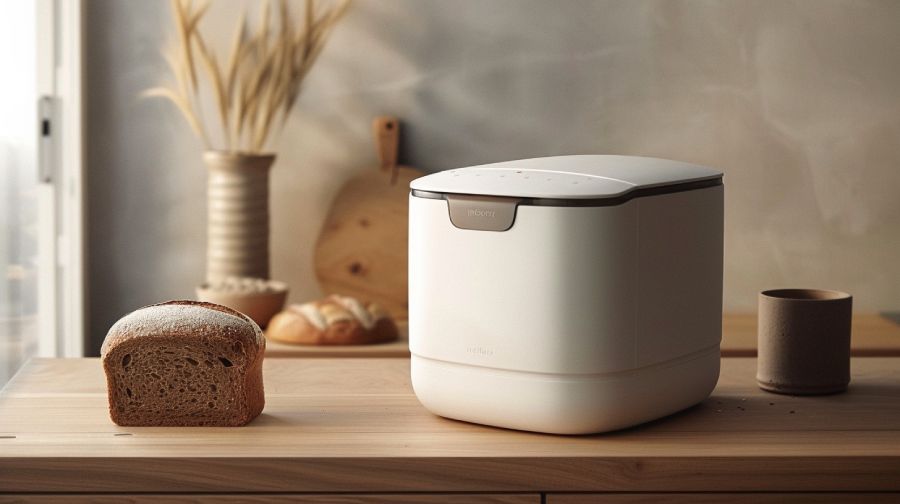
When using a bread machine to make sourdough, selecting the right settings is essential for achieving that perfect rise and flavor. Different machines have unique requirements, so knowing your bread machine settings is vital. For instance, the Zojirushi BB-PAC20 has specific dough and bake settings that are ideal for sourdough. In contrast, Panasonic models might require you to use the kneading mode as they lack a dedicated sourdough setting.
Here are some tips to help you navigate your settings:
- Use the pizza dough setting for effective sourdough preparation, ensuring the dough reaches the right consistency.
- For Panasonic models, consider utilizing menu 22 for proper dough fermentation, allowing your sourdough starter to rise adequately.
Frequently Asked Questions
Are Bread Machines Good for Sourdough?
Yes, bread machines are great for sourdough! They simplify the process, allowing you to adjust kneading and baking cycles. With a long-rising option, you’ll achieve a delicious, high-rising loaf with minimal effort.
What Is the Secret to Good Sourdough Bread?
You’d think sourdough’s secret lies in magic, but it’s all about your starter’s vigor, proper hydration, and meticulous fermentation. Focus on quality flour and timing, and you’ll craft a loaf that sings with flavor.
Why Do You Put Vinegar in Sourdough Bread?
Add vinegar to sourdough bread to boost acidity, enhancing gluten development and flavor. It also inhibits unwanted bacteria, promotes healthier fermentation, and helps extend shelf life by maintaining moisture. It’s a game-changer for your bread!
Is Sourdough Bread Harder to Make Than Regular Bread?
Sourdough’s sophisticated science surely seems tougher than traditional bread. You’ll navigate nurturing a starter, mastering fermentation, and timing your rises. Though challenging, the flavorful rewards and health benefits make the effort worthwhile.
Set Your Bread Maker: The Magic of Baking Perfect Sourdough at Home
With this sourdough bread recipe, you’re not just baking bread; you’re creating a warm, inviting aroma that fills your kitchen, a crusty exterior that beckons you, and a chewy, tangy interior that delights your taste buds.
Embrace the process, savor the results, and enjoy the satisfaction of homemade sourdough.
So, gather your ingredients, set your bread maker, and let the magic happen.
You’ll soon experience the joy of crafting a timeless classic right at home.

